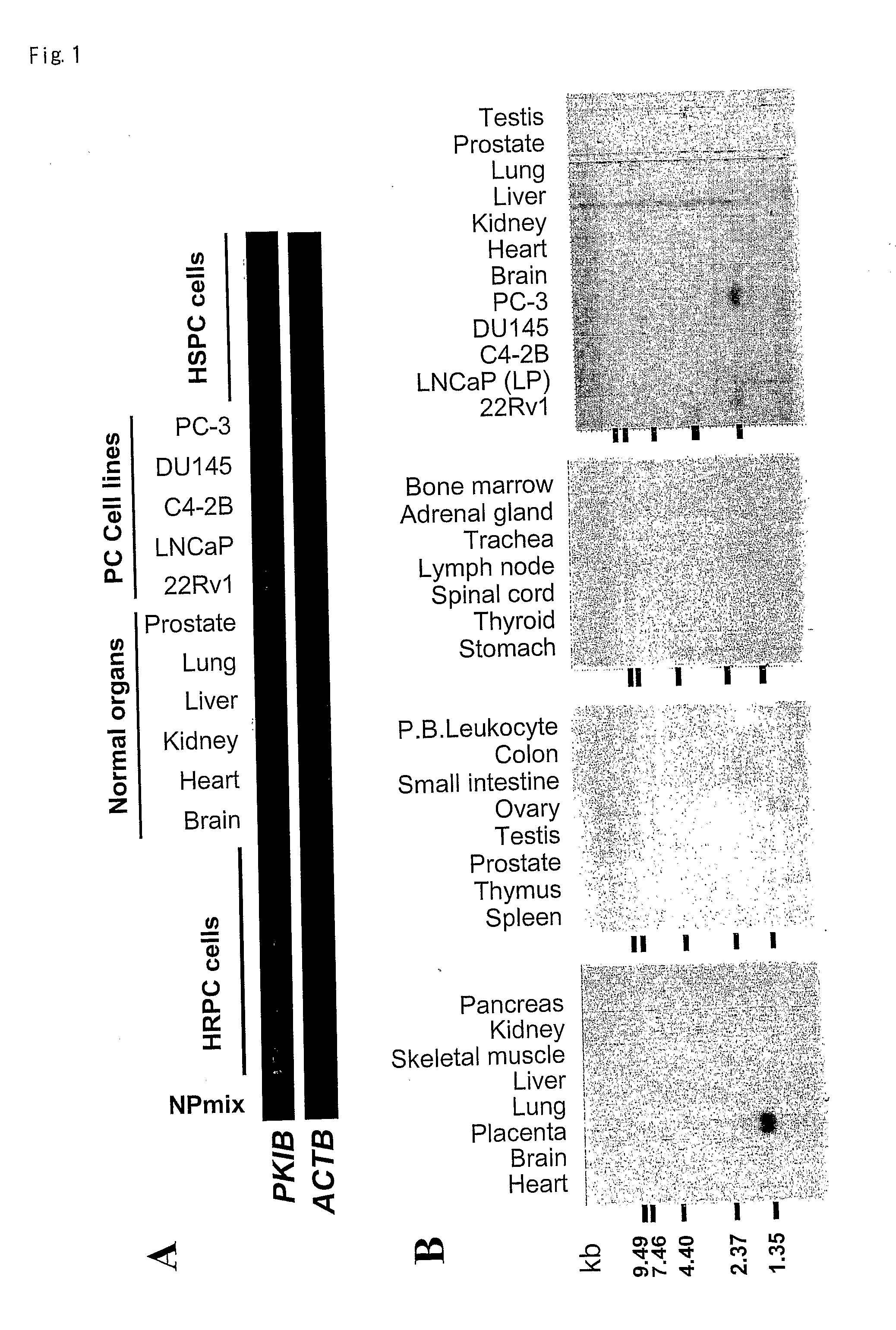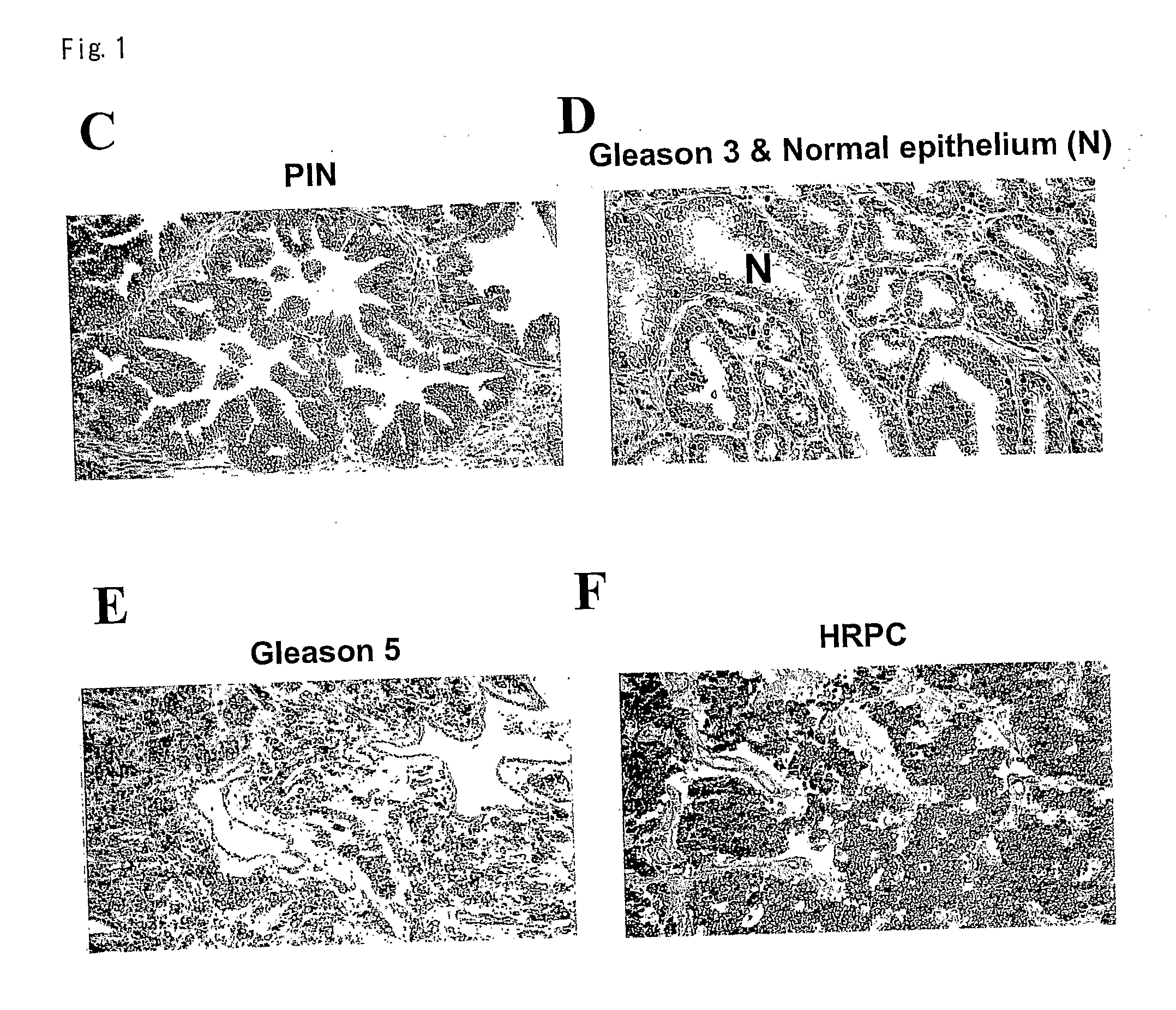PKIB and NAALADL2 for Target Genes of Prostate Cancer Therapy and Diagnosis
a prostate cancer and target gene technology, applied in the field of biological science, can solve the problems of not providing a cure and limited survival benefit of hrpc patients, and achieve the effect of reducing the expression level of pkib or naaladl2 protein and reducing the symptom of prostate cancer
- Summary
- Abstract
- Description
- Claims
- Application Information
AI Technical Summary
Benefits of technology
Problems solved by technology
Method used
Image
Examples
example 1
General Methods
Cell Lines
[0432]COS7 cell and, PC cell lines LNCaP, 22Rv 1, PC-3, DU-145 and C4-2B were purchased from the American Type Culture Collection (ATCC, Rockville, Md.), and LNCaP-derived HRPC cell line C4-2B was purchased from ViroMed Laboratories (Minnetonka, Minn.). LNCaP that was passed more than 30 times was defined as LNCaP(HP), which was different from LNCaP cell at low passage morphologically and at their gene-expression pattern. They were grown in Delbecco's modified Eagle's medium (Invitrogen, Carlsbad, Calif.); this media were supplemented with 10% fetal bovine serum (Gemini Bio-Products, West Sacramento, Calif.) and 1% antibiotic / antimycotic solution (Sigma-Aldrich, St. Louis, Mo.). Cells were maintained at 37° C. in atmospheres of humidified air with 5% CO2.
Semi-Quantitative RT-PCR
[0433]Purification of PC cells and normal prostatic epithelial cells from frozen PC tissues was described previously (Tamura K et al., Cancer Res 2007 67: 5117-25.). Tissue samples we...
example 2
Over-Expression of PKIB and NAALADL2 in PC Cells
[0445]Among dozens of trans-activated genes that were screened by genome-wide cDNA microarray analysis of HRPC cells (Tamura K et al., Cancer Res 2007 67: 5117-25.), PKIB and NAALADL2 were focused in this invention. PKIB over-expression was confirmed by RT-PCR in five of the nine microdissected HRPC cell populations (FIG. 1A), and NAALADL2 over-expression was confirmed by RT-PCR in five of the nine (FIG. 2A).
[0446]The expression of both genes in normal organs including heart, lung, liver, and kidney was minimum, and HRPC cells showed higher expression of the both genes comparing to that of hormone-sensitive or naïve PC cells. Northern-blot analysis using cDNA fragment of PKIB as the probe identified an about 1.3-kb transcript specifically in placenta and PC cell lines, but no expression was observed in any other organs including lung, heart, liver, kidney, and brain (FIG. 1B). Northern-blot analysis using cDNA fragment of NAALADL2 as t...
example 3
Knockdown of PKIB by siRNA on PC Cell Lines
[0448]To investigate a potential growth-promoting role of PKIB aberrant expression, several siRNA-expression vectors were constructed to examine their knockdown effects on a PKIB-expressing PC cell line, 22Rv1, and LNCaP (HP) cells. When si1 and si2 constructs were transfected to 22Rv1 cells (left) and LNCaP (HP) cells (right), a significant knockdown effect was observed by semi-quantitative RT-PCR, but #3si and a negative siRNA construct siEGFP did not (FIG. 3A). After selection in culture medium containing Geneticin, MTT assay (FIG. 3B) and colony formation assay (FIG. 3C) demonstrated that introduction of si1 and si2 in 22Rv1 cells (left) and LNCaP (HP) cells (right) drastically attenuated their cell growth or viability, while that of other siRNAs, which could not affect PKIB expression, did not affected cell growth, indicating that PKIB is likely to play important roles of PC cell viability.
PUM
| Property | Measurement | Unit |
|---|---|---|
| Fraction | aaaaa | aaaaa |
| Length | aaaaa | aaaaa |
| Electrical resistance | aaaaa | aaaaa |
Abstract
Description
Claims
Application Information
 Login to View More
Login to View More - R&D
- Intellectual Property
- Life Sciences
- Materials
- Tech Scout
- Unparalleled Data Quality
- Higher Quality Content
- 60% Fewer Hallucinations
Browse by: Latest US Patents, China's latest patents, Technical Efficacy Thesaurus, Application Domain, Technology Topic, Popular Technical Reports.
© 2025 PatSnap. All rights reserved.Legal|Privacy policy|Modern Slavery Act Transparency Statement|Sitemap|About US| Contact US: help@patsnap.com



